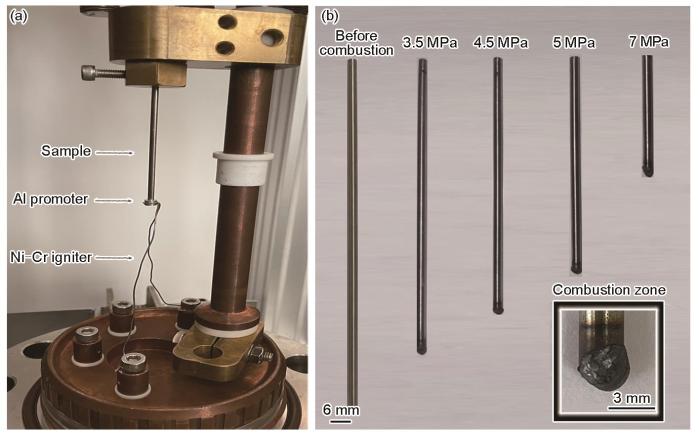从20世纪80年代开始,国外已经对高温合金富氧燃烧问题开展了较系统的研究,并定期组织金属燃烧领域的学术会议[8,9]。目前,美国富氧燃烧实验设备已经相当完善[10~12],美国国家航空航天局(NASA)白沙测试设施可进行压强达68.9 MPa、温度达1373 K的富氧燃烧测试[13]。美国材料与试验协会(ASTM)还建立了PIC (promoted ignition-combustion)实验装备及测试方法的相关标准[11,14]。但是,从公开报道看,国外一系列研究工作主要集中在对大量不同类型金属的抗富氧燃烧性能进行评估方面[15~18],例如通过PIC实验测定了在室温下O2浓度大于99.5%时,IN718合金的燃烧压强阈值为3.5 MPa,点燃温度约为1600 K[19]。随着实验所用试棒直径减小、实验温度提高和O2浓度增大,合金燃烧长度增加,抗富氧燃烧性能下降[16,20~22]。国内相关研究起步较晚,直到2001年发生了火箭发动机涡轮燃烧事故以后才开展了相关研究[1,23,24],前期基于国内开发的PIC实验装置(压强≤ 2 MPa,室温点燃),对GH4169、GH4202和GH4586等高温合金进行了富氧燃烧实验[25],初步探索了合金燃烧机理。
目前,国内外的研究都发现试棒前端首先会被燃烧放出的大量热量熔化,随后合金以液相进行燃烧,燃烧中合金元素存在选择性燃烧行为,即燃烧热高的Nb、Ti、Al、Cr等元素会优先与O2发生燃烧反应,而燃烧热低的Ni元素存在滞后燃烧现象。但是目前国内外针对合金燃烧机理的研究均未见报道,尤其是对于燃烧过程中氧化物的产生及演化和燃烧的热、动力学分析等关键问题均未涉及。本工作基于自主研制的最高压强可达25 MPa的PIC设备,对GH4061合金进行了高压富氧燃烧实验,报道了合金在最高25 MPa高压纯O2下的燃烧行为,同时分析了GH4061合金的富氧燃烧机理。
1 实验方法
1.1 实验材料
GH4061合金的名义成分(质量分数,%)为:C 0.04,Al 0.9,Ti 0.6,V 0.45,Cr 16.5,Fe 14,Cu 0.55,Nb 4.75,Mo 4,Ni余量。采用真空感应炉冶炼合金锭,经过开坯锻造锻成30 mm × 30 mm的方棒,随后对试棒进行热处理,热处理制度为1293 K、3 h (空冷) + 1003 K、15 h (空冷) + 923 K、10 h (空冷)[26],合金平均晶粒尺寸约为30 μm。通过线切割等机械加工方法,将样品加工成直径3.17 mm、长110 mm的细棒。
1.2 实验方法
如图1a所示,试棒垂直固定于燃烧室内部(悬挂长度为101 mm),Al助燃剂置于试棒下端且与试棒紧密相连,在助燃剂外部缠绕Ni-Cr电阻丝用于点燃试棒。实验前,试棒和助燃剂均用超声清洗,以避免加工中的油污影响实验结果。在点燃助燃剂之前,首先使用纯O2吹扫整个通气系统,将实验腔室内的空气排尽,随后对实验腔室充气并达到实验所需的压强,最后使用GC112A气相色谱仪检测腔室内O2的浓度。本实验的O2浓度均大于99.5%,实验温度为室温,实验压强为3.5~25 MPa,每个压强下进行2~3次实验。当腔室内的O2浓度和压强达到要求时,加热电阻丝以引燃助燃剂,通过HAS-EF高速相机(时间分辨率1/14000 s)观察并记录燃烧过程。待燃烧停止,泄压排空腔室内的O2后打开实验腔室取下试棒。
图1
图1
实验腔室内部试棒放置方式及不同压强下燃烧前后的试棒
Fig.1
Experimental setup in PIC test chamber (a) and comparison of samples before and after combustion at different pressures (Inset shows the combustion zone) (b)
2 实验结果
2.1 燃烧过程
图2
图2
GH4061合金在实验压强为3.5 MPa时的燃烧过程
Fig.2
High-speed camera images of combustion process of GH4061 alloy in 3.5 MPa PIC test (PIC—promoted ignition-combustion)
(a, b) ignite the promoter (c-h) a burn-drop cycle (i-k) the end of burning
2.2 燃烧实验结果
图3
图3
GH4061合金在不同压强(P)下燃烧后相对剩余长度和燃烧速率(V)
Fig.3
Length remaining (a) and burning rate (V) (b) of GH4061 alloys after PIC test at different pressures (P) (R2—correlation coefficient)
2.3 燃烧试棒燃烧区域组织分析
图4
图4
GH4061合金在7 MPa压强下燃烧后燃烧区域的截面组织
Fig.4
Cross sectional microstructures of combustion zone of GH4061 alloy after combustion at 7 MPa
(a) original alloy, transition zone, and melting zone (b) fine dendrites in transition zone (c) melting zone
氧化物区为合金燃烧时附着在熔化区前端的混合氧化物。图5为GH4061合金在7 MPa压强下燃烧结束后,熔化区、燃烧前沿和氧化物区的元素分布。可以看出,Ni、Cu等元素主要集中在熔化区,燃烧前沿主要富集Al、Ti、V、Cr、Nb等元素,同时Cr、Fe等元素经燃烧后进入氧化物区。Ni作为合金的主要元素在氧化物区含量很低。
图5
图5
GH4061合金在7 MPa压强下燃烧后燃烧区域前端氧化物区形貌以及EDS元素分布
Fig.5
Morphology and EDS elements distribution in oxide zone of combustion zone for GH4061 alloy after combustion at 7 MPa
图6为GH4061合金在7 MPa压强下燃烧后熔化区中球形氧化物的形貌和元素分布。从图6a可以看出,合金熔化区内存在大量球形氧化物,且尺寸不一,其直径在0.1~100 μm范围内。按照形貌,可将球形氧化物分为2种:一种是直径在6 μm以上的大尺寸球形氧化物,内部为明显的凝固树枝晶形貌(图6b和c),其位置均位于过渡区细枝晶前沿;另一类是直径在6 μm以下的小尺寸球形氧化物,为实心球形貌(图6d)。经EDS分析,实心氧化物主要富O、Al、Ti等元素,而大尺寸氧化物内部组织较为复杂,O和Al元素主要分布于枝晶干区域,O、Nb、Ti元素主要分布于枝晶间区域,在枝晶间还有少量含有O、Cr、V等元素和残留金属Ni和Cu的区域(图6c)。
图6
图6
GH4061合金在7 MPa压强下燃烧后燃烧区域内熔化区球形氧化物形貌
Fig.6
Morphologies of spherical oxides in melting zone of combustion zone for GH4061 alloy after combustion at 7 MPa
(a) melting zone (b) large (> 6 μm) spherical oxide
(c) details in large spherical oxide (d) small (< 6 μm) spherical oxides
2.4 燃烧产物
实验压强为3.5、7和25 MPa时,合金燃烧后的氧化产物XRD谱如图7所示。可以看出,不同的压强下燃烧产物构成复杂,种类基本相同。虽然大部分Ni和Cu保留在熔化区,但产物中观察到NiO和Ni0.95Cu0.05O,说明部分Ni和Cu在高压富氧条件下会与O2发生反应。
图7
图7
GH4061合金在3.5、7和25 MPa压强下燃烧后燃烧产物的XRD谱
Fig.7
XRD spectra of combustion products of GH4061 alloys after combustion at 3.5, 7, and 25 MPa
3 分析讨论
3.1 燃烧机理
金属燃烧行为与其燃烧热密切相关,不同金属元素的燃烧热及相应氧化物的密度、熔点等见表1[2]。根据燃烧过程和燃烧后的组织,可以推断试棒的燃烧过程,如图8所示。燃烧开始时,Al助燃剂燃烧使合金迅速升温,局部熔化。熔化区金属与周围的O2发生强烈的氧化反应,从图5的成分分布可以推断,燃烧热较高的Al、Ti、V等元素优先燃烧,在燃烧前沿形成富Al、Ti、V的氧化物,燃烧热较低的Cr、Nb、Fe、Mo等元素随后大量燃烧形成氧化物,其中Mo会形成挥发性氧化物[13],因此在燃烧结束后的试棒中几乎观察不到含Mo的氧化物。燃烧热最低的Ni、Cu只有少量参与燃烧,大部分保留在熔化区中(图8a)。燃烧释放的热量使金属熔化,燃烧界面上移,试棒前端熔融液滴逐渐变大(图8b)并携带表面氧化物滴落。当燃烧释放的热量逐渐减少,无法维持熔化试棒、液滴滴落的过程时,试棒前端熔融液滴不再变大(图 8c),试棒逐渐冷却,最终在试棒前端形成疏松氧化物包裹熔化区的形貌。尽管XRD结果显示,随压强的增加燃烧产物种类基本相同,但由于氧化物种类繁多、成分复杂,未来需要更精确的分析方法对氧化物进行定量表征。
表1 金属元素的燃烧热及其氧化物熔点、密度[2]
Table 1
| Element | Heat of | Oxide | Melting |
|---|---|---|---|
| combustion | density | point | |
| kJ·mol-1 | g·cm-3 | K | |
| Al | 842 | 3.50 (Al2O3) | 2327 |
| Ti | 912 | 4.26 (TiO2) | 2113 |
| V | 752 | 3.35 (V2O5) | 963 |
| Cr | 565 | 5.21 (Cr2O3) | 2708 |
| Nb | 967 | 4.47 (Nb2O3) | 1758 |
| Fe | 364 | 5.18 (Fe3O4) | 1867 |
| Mo | 751 | 4.69 (MoO3) | 1068 |
| Ni | 240 | 6.67 (NiO) | 2253 |
| Cu | 159 | 6.32 (CuO) | 1599 |
图8
图8
GH4061合金燃烧过程示意图
Fig.8
Schematics of combustion process of GH4061 alloy (x1—thickness of melting zone, x2—thickness of oxide zone, T1—flame temperature, T2—combustion front temperature, T3—transition zone temperature)
(a) combustion start (b) generation and movement of oxides (c) combustion stop
分析燃烧过程中球形氧化物的产生与运动可以简单推测燃烧过程中的温度变化和组织演化(图8a)。燃烧会释放大量的热,文献[28]报道IN718合金在高压富氧条件下发生燃烧时,火焰最高温度T1高达2773 K,这时燃烧形成的氧化物均处于熔融状态。试棒的过渡区温度T3约为1573 K (GH4061合金液相线温度),因此氧化物区-燃烧前沿-熔化区-过渡区会存在一个明显的温度梯度。经测量,燃烧后样品熔化区厚度x2约为1.2 mm,氧化物区厚度x1在0.5~1.0 mm之间,λ1与λ2分别为氧化物区和熔化区的热导率。根据Fourier定律q = -λ(dT' / dx) (其中q为热流密度,λ为热导率,
考虑到氧化物成分较为复杂,本工作仅根据单质金属元素及其氧化物进行粗略分析。由于GH4061合金熔化后密度大约为6.81 g/cm3,而氧化物密度较低(表1[2]),因此熔融的氧化物中部分密度较低的Al2O3、Nb2O3和TiO2会优先上浮,并在上浮过程中逐渐凝固。其中,尺寸较小的氧化物主要为Al2O3和TiO2;尺寸较大的氧化物成分比较复杂,在上浮过程中会凝固成内部为枝晶结构的球形氧化物,由于Ti、Al、Nb的氧化物中Al2O3的熔点最高,因此会优先凝固于枝晶干位置,随后Nb、Ti等氧化物凝固于枝晶间部位,由于尺寸较大,这种球形氧化物在上浮过程中还包裹了少量未燃烧的金属Ni和Cu以及Cr和V的氧化物(图6)。尺寸较大的氧化物受到的浮力更大,所以会观察到图4中大尺寸氧化物更靠近过渡区分布的形貌。固体氧化物颗粒的上浮是重力和浮力综合作用的结果,但重力除了影响上浮之外,还会降低试样的燃烧速率和熔融氧化物区温度[29]。
3.2 燃烧的热力学分析
式中,ΔGΘ为标准Gibbs自由能;R为理想气体常数;T为火焰周围温度;J为压力商;KΘ为平衡常数;
式中,ai 和bi 为常数。
图9给出了GH4061合金试棒在不同压强下燃烧时,KΘ随T的变化规律。本实验压强范围为3.5~25 MPa,对应J的变化范围为-2.58~-4.02。图9的插图中对比了根据
图9
图9
GH4061合金燃烧反应的lnKΘ-T曲线图以及比较lnKΘ与实验O2压强的lnJ
Fig.9
lnKΘ as a function of T,andcomparison of lnKΘ and lnJ within the experimental pressure range of O2 (inset) of combustion reaction for GH4061 alloy (KΘ—equilibrium constant, J—pressure quotient, T—temperature around the flame)
3.3 压强对燃烧行为的影响
燃烧过程中会连续发生以下3个过程[32]:(1) O2在氧化物边界处发生物理、化学吸附,并进入到熔融氧化物;(2) O2通过熔融氧化物层向内扩散;(3) 在氧化物-金属边界处(燃烧前沿)发生燃烧反应。O2吸附及其在熔融氧化物区扩散的速率和压强P成正比[33],但O2进入熔融氧化物的速率与P0.5成正比[32],因此O2进入熔融氧化物的过程是燃烧速率的决定因素。GH4061的燃烧速率与压强之间存在V ∝ P0.27的关系(图3b),这与文献[12]报道的IN718合金燃烧速率(V ∝ P0.25)相近,也进一步说明O2进入熔融氧化物的过程是影响燃烧速率的关键因素[20,32]。GH4061和IN718燃烧速率与P的关系式中,指数的略微差异可能源于2种合金成分的不同。
4 结论
(1) 随着O2压强增加,GH4061试棒的燃烧长度逐渐增加,当O2压强超过10 MPa时,燃烧过程不会自动停止。根据ASTM G124标准,GH4061合金在99.5%纯O2室温点燃条件下,燃烧阈值约为5 MPa。试棒燃烧速率随压强提高而增大,2者之间存在近似的幂函数关系:V ∝ P0.27。
(2) GH4061合金在高压富氧环境下燃烧时,试棒自下而上依次为熔融氧化物区、燃烧前沿、熔化区、过渡区和未燃烧区。O2通过熔融氧化物区扩散至燃烧前沿与熔融金属发生反应,燃烧热较高的元素(如Al、Ti、V)优先燃烧,燃烧热较低的元素(如Ni和Cu)仅少量参与燃烧。
(3) GH4061合金在高压富氧环境下燃烧时,从外向内存在较大的温度梯度,外层熔融氧化物中部分密度较低的熔融氧化物Al2O3、Nb2O3和TiO2会优先上浮,并在上浮过程中逐渐凝固,形成尺寸较小(< 6 μm)的Al或Ti的氧化物和尺寸较大的混合氧化物。
(4) 热力学分析表明,随燃烧反应释放的热量逐渐积累,燃烧区温度上升,反应的平衡常数下降,当温度到达某一临界值时,平衡常数小于压力商,此时燃烧停止。
参考文献
Combustion failure analysis of GH202 and GH586 superalloys for rocket engine
[J].
火箭发动机用合金GH202和GH586燃烧事故分析
[J].
Combustion of metals in oxygen
[J].
An insight into ignition factors and mechanisms of magnesium based materials: A review
[J].
Combustion behaviour and mechanism of a Cu-Ni-Mn alloy in an oxygen enriched atmosphere
[J].
Metal combustion in high-pressure flowing oxygen
[A].
High temperature oxidation and ignition of metals
[R].
Techniques employed by the NASA White Sands Test Facility to ensure oxygen system component safety
[A].
ASTM G 63: A milestone in a 60-year safety effort
[A].
Promoted ignition-combustion behavior of cobalt and nickel alloys in oxygen-enriched atmospheres
[A].
Burn propagation rates of metals and alloys in gaseous oxygen
[A].
Promoted ignition-combustion behavior of engineering alloys at elevated temperatures and pressures in oxygen gas mixtures
[A].
Pressurized flammability limits of metals
[A].
Promoted combustion of pure metals in oxygen-enriched atmospheres
[A].
Promoted ignition-combustion behavior of selected hastelloys in oxygen gas mixtures
[A].
An assessment of the flammability hazard of several corrosion resistant metal alloys
[A].
ASTM committee G-4 metals flammability test program data and discussion
[A].
Combustion of 316 stainless steel in high-pressure gaseous oxygen
[A].
Ignition and combustion of titanium and titanium alloys
[A].
Configurational effects on the combustion of several alloy systems in oxygen-enriched atmospheres
[A].
Oxidation characteristic and mechanism of superalioys in oxygen-enriched atmosphere
[J].
富氧气氛下高温合金氧化特征及机理
[J].
Research on combustion characteristics and properties of superailoy in high-pressure and oxygen-enriched atmosphere
[J].
高压富氧下几种高温合金的燃烧特征和性能研究
[J].
Combustion behavior of GH4169 and GH4202 superalloys in oxygen-enriched atmosphere
[J].
高温合金GH4169与GH4202在富氧气氛中的燃烧行为
[J].
Study on the effect and mechanism of V, Cu in a new Ni-Cr-Fe-Nb superalloy
[D].
V、Cu在新型Ni-Cr-Fe-Nb高温合金中的作用机理研究
[D].
Ignition and combustion temperatures determined by laser heating
[A].
Microgravity and normal gravity combustion of metals and alloys in high pressure oxygen
[A].
T-G diagram and its applications to high temperature oxidation of pure metals
[J].
Promoted metals combustion at ambient and elevated temperatures
[A].
Prediction of metal fire spread in high-pressure oxygen
[J].
The rate determining process of iron oxidation at combustion in high pressure oxygen
[J].













